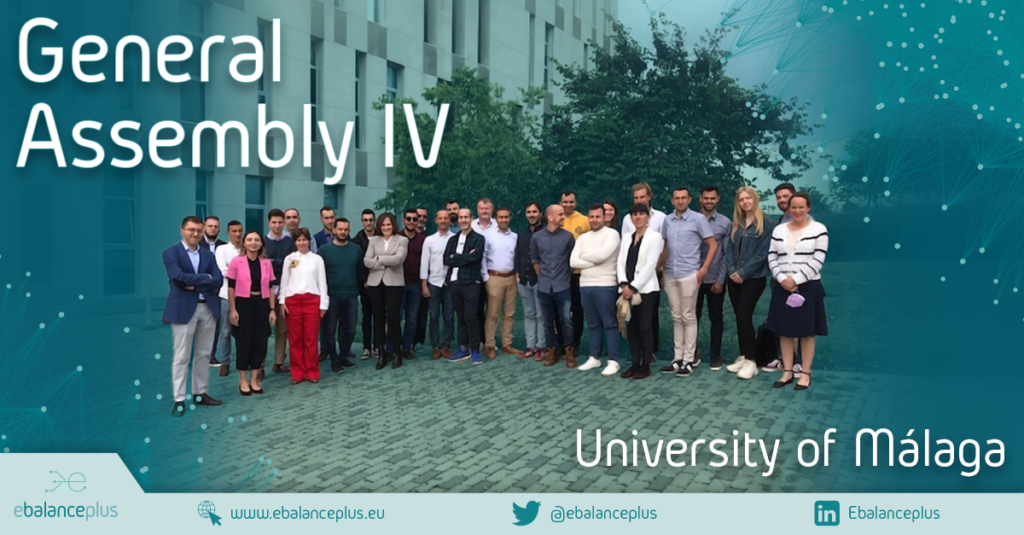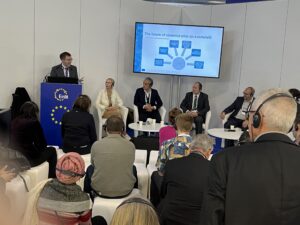
To accelerate the energy transition to reach the European ambition and reduce EU´s emissions by at least 55% in 2030, we need to integrate more renewables in our power networks. This causes large challenges and calls for flexible use of power and new mechanisms to balance supply and demand.The ebalance-plus project contributes to this large challenge by increasing the energy flexibility of distribution grids.
From 26 to 29 May 2022, the ebalanceplus-plus consortium met in Málaga, Spain, to summarise the general progress of the project. After 26 months of research and cooperation – mostly in a virtual way – the 15 partners from 10 countries had finally the chance to visit the technology developments of University of Málaga, one of the four demonstration sites of the project.
The core of the project is the development of a comprehensive ICT communication platform where different electric grid players and operators (for example prosumers, DER exploitation managers, energy aggregators and DSOs) can deal with the available flexibility to increase the grid stability and security. The energy balancing platform can thus contribute to unlocking Europe´s energy flexibility markets in distribution grids and thereby support energy prosumers and electric operators.
In this second phase of the project the researchers are going to deploy all the technologies in the four demo sites – Spain, Italy, France and Denmark. This is the most important part because a demonstration is happening at the end of 2022 and all the technology developed has to be integrated for the end of the project in July 2023. Jacobo Peralta, ebalance-plus coordinator from CEMOSA, explains :
”The main objectives of all real pilots is flexibility. Energy flexibility is the way in which we increase or reduce our power consumption in order to cooperate with the smart grid. For our Málaga demo site the main focus lies on the vehicle to grid solutions. We’re asking us how to extent the use of the battery, how can the battery be used for providing flexibility at district level or at building level and even from home to the office and from the office to home.”
Another very important aspect is to explore the user acceptance and the user profiling, underlines Peralta: “If this generation and the further ones do not understand the energy concept, we’ll have a problem because they are the users of our solutions in the future. For this reason, the Mobile App for energy flexibility is very important. One of the objectives of the Mobile App is that the people understand what they are doing with the energy. The students of University of Málaga will be our first users of the Mobile App.”
At the end of the project the different demo sites will present a Business Model, allowing to sell the services they developed on the Electricity Market, helping to replicate these solutions in other places, buildings and parkings and in general to deliver sustainable and viable solutions, even after the end of the project.

Towards a clean, affordable and reliable energy system: ebalance-plus’ technology solutions allow the management of green and flexible electricity.
One day after the announcement of the European Action Plan for Grids, the EU-funded project ebalance-plus presents its market ready flexibility management solutions at the ENLIT fair (Paris, France).
After four years of EU funded research and testing, the ebalance-plus project has demonstrated success in creating smarter, more efficient energy grids with use of innovative technologies. On 29 November 2023 at the ENLIT fair in Paris, the project held its final conference, presenting the different smart technologies to the professional audience on site.
“Ebalance-plus aims to digitalise the electricity system in such a way that end-customers are involved and participate jointly with energy suppliers and distributors, to achieve mutual benefit and open the door to new flexibility markets”, explains Juan Jacobo Peralta from CEMOSA, coordinator of the project.
The pressure on European power networks has been mounting and grid bottlenecks are delaying Europe’s clean transition. The energy sector requires a deep transformation to meet the demands of future. Now Europe is ready to take on the challenges and unlock the investments needed: The Commission’s European Action Plan for Grid, announced by Commissioner Kadri Simson on 28 November 2023, focuses on the grid of the future that will have to support a more decentralised, digitalised and flexible system including rooftop solar panels, energy storage systems, heat pumps, electric vehicles, local energy communities, and increasing hydrogen production.
The necessary flexibility solutions have been presented and discussed at the final conference of ebalance-plus and Distribution System Operators, researchers and aggregators agree that there is political momentum and a unique opportunity to accelerate change in upgrading and digitalising Europe´s electricity grid.
The ebalance-plus consortium brings together 15 partners – research centres, SMEs and industry representatives – from 10 countries. They worked together to increase flexibility of energy grids, develop new business models and support key stakeholders with tailored end-user interfaces. They tested a variety of solutions in four real pilots in Spain, Italy, France and Denmark. To ensure the adequacy of the solutions, additional in-lab tests tackled security and reliability issues. The European Union supports the project within the Horizon 2020 framework with almost 10 million euro.